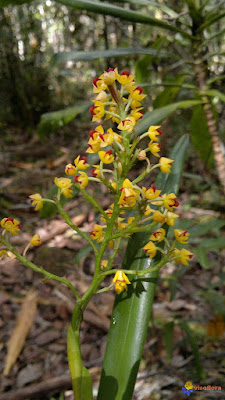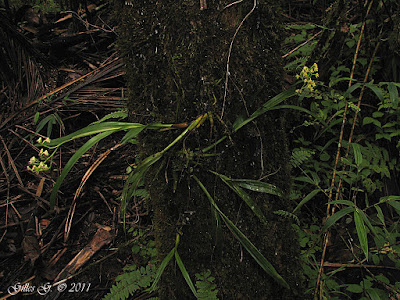Polystachya rhodochila is found in Madagascar. Its grow in the moss and lichen-covered forests on the northern part of the island at elevations of 1400-2000 meters.
Polystachya rhodochila also called as The Red Lipped Polystachya, is a species of the genus Polystachya. This species was described by Friedrich Richard Rudolf Schlechter in 1916.
IDENTIFY POLYSTACHYA RHODOCHILA ORCHID PLANT
Polystachya rhodochila is found in Madagascar. Its grow in the moss and lichen-covered forests on the northern part of the island at elevations of 1400-2000 meters.
It is a medium sized, 30-50 cm tall, cool growing terrestrial or occasional epiphyte with cauliform pseudobulbs carrying 3 to 4 linear-lingulate, slightly attenuate basally, 17-25 cm long, 1.2-2 cm wide leaves.
The Red Lipped Polystachya blooms in the spring and summer on a 20 cm long, branched inflorescence with 2 ancipitous, wide sheaths and narrowly lanceolate floral bracts that are longer than the flowers. The flowers are white with a rose pink lip, slightly warty, glabrous.
POLYSTACHYA RHODOCHILA ORCHID PLANT CARE AND CULTURE
Cultural information should only be used as a guide, and should be to be adapted to suit you. Your physical location; where you grow your plants, how much time you have to devote to their care, and many other factors, will need to be taken into account. Only then can you decide on the cultural methods that best suit you and your plants.
Light:
Polystachya rhodochila needs a light level of 25000-35000 lux. Light should be filtered or diffused, and the plants should not be exposed to direct midday sun. Strong air movement should be provided at all times.
Temperature:
Summer days temperature at average 22-23°C, and nights average 14°C, with a diurnal range of 7-8°C. These plants should thrive if placed in the cool, moist airflow near an evaporative cooler.
Humidity:
The Red Lipped Polystachya need the humidity of 80-85% from midsummer to early autumn, dropping gradually to near 65% in winter and early spring, and then increasing gradually during spring.
Substrate, growing media and repotting:
Polystachya rhodochila may be grown in relatively small pots or baskets filled with an open, fast-draining medium that retains some moisture after watering. The medium should dry out between waterings, however. The standard fir-bark mixes work well for many growers.
Plants may also be mounted tightly to a tree-fern slab. If mounted, however, high humidity must be maintained and the plants watered at least once daily in summer. Several waterings a day may be necessary for mounted plants during extremely hot, dry weather.
These orchids appear to grow better when allowed to form large clumps, so they should be divided as little as possible. Repotting, mounting, or dividing should be done only when new root growth is just starting. This allows the plant to become established in the shortest possible time with the least amount of stress.
Watering:
Rainfall in the habitat is heavy in summer and early autumn, with averages falling quickly into a 5 to 6 months dry season that extends from late autumn into early spring. Plants should be watered heavily while actively growing, but drainage must be excellent, and water should be reduced in autumn after new growth has matured.
Fertilizer:
1/4-1/2 recommended strength, applied weekly when plants are actively growing. You can use a balanced fertilizer throughout the year; but also can use a high-nitrogen fertilizer from spring to midsummer, then switch to one high in phosphates in late summer and autumn.
Rest period:
Winter days temperature at average 19-20°C, and nights average 11-12°C, with a diurnal range of 8°C. Water should be reduced for Polystachya rhodochila from late autumn into the following spring, but they should not remain completely without water for long periods. Occasional early-morning mistings between infrequent light waterings should provide sufficient moisture in most growing areas. Water should be increased if pseudobulbs shrivel excessively. Fertilizer should be eliminated until new growth starts and heavier watering is resumed in spring.















COMMENTS